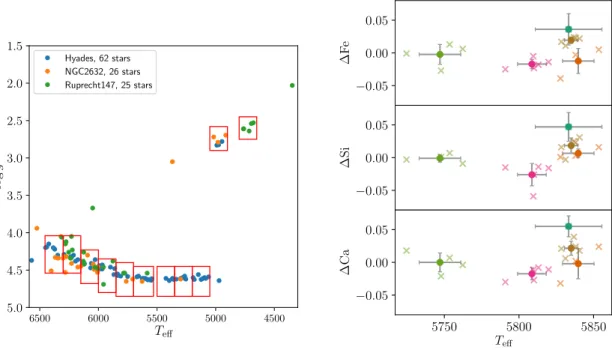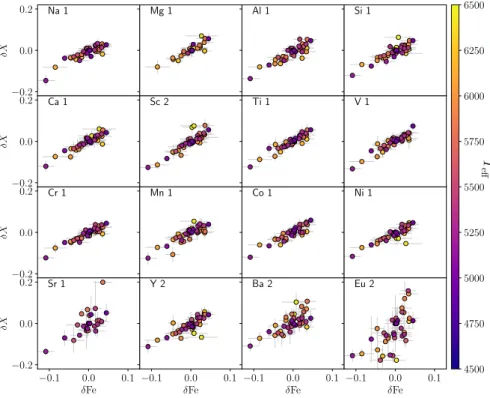HAL Id: hal-03052910
https://hal.archives-ouvertes.fr/hal-03052910
Submitted on 18 Dec 2020
HAL is a multi-disciplinary open access
archive for the deposit and dissemination of
sci-entific research documents, whether they are
pub-lished or not. The documents may come from
teaching and research institutions in France or
abroad, or from public or private research centers.
L’archive ouverte pluridisciplinaire HAL, est
destinée au dépôt et à la diffusion de documents
scientifiques de niveau recherche, publiés ou non,
émanant des établissements d’enseignement et de
recherche français ou étrangers, des laboratoires
publics ou privés.
DIFFERENTIAL CHEMICAL ABUNDANCES OF
BENCHMARK OPEN CLUSTERS
L Casamiquela, C Soubiran, Y Tarricq
To cite this version:
L Casamiquela, C Soubiran, Y Tarricq. DIFFERENTIAL CHEMICAL ABUNDANCES OF
BENCH-MARK OPEN CLUSTERS. Annual meeting of the French Society of Astronomy and Astrophysics,
May 2019, Nice, France. �hal-03052910�
DIFFERENTIAL CHEMICAL ABUNDANCES OF BENCHMARK OPEN CLUSTERS
L. Casamiquela
1, C. Soubiran
1and Y. Tarricq
1Abstract. Open Clusters (OCs) are very good laboratories to test theories of stellar evolution. They have also been widely used as tracers of the formation and evolution of the Galactic disk. Nearby OCs with different ages and metallicities are commonly used as benchmark objects for galactic and stellar studies because high precision measurements are usually achievable. We aim to perform a detailed study of ∼30 nearby (closer than 500 pc) and old (age>300 Myr) OCs. Thanks to Gaia DR2, accurate memberships, distances, motions and ages are available for a large amount of OCs, allowing us to revise their physical properties. Here we show the preliminary results of the strictly line-by-line differential abundances of three targets: the Hyades, NGC 2632 (Praesepe) and Ruprecht 147.
Keywords: (Galaxy:) open clusters and associations: individual: Hyades, NGC 2632, Ruprecht 147, Stars: abundances, Techniques: spectroscopic
1 Introduction
OCs are groups of stars which were born together and that still stay together nowadays. They have recieved much attention lately because: i) they are good targets to test theories of stellar evolution since stellar pop-ulation covers a large range of spectral types, ii) they trace the history of the galactic disk, iii) nearby OCs spanning different ages and chemical compositions are used to validate and calibrate astrometric, photometric and spectroscopic surveys (e.g. Gaia, APOGEE, RAVE, WEAVE among many others).
Most of the stars are thought to be formed in clusters. However, due to internal interactions between members, encounters with giant molecular clouds, among other effects, they tend to disrupt during the first Myr of evolution. So, old OCs which have overcomed these effects are important targets to understand the formation and evolution of the Galactic disk.
We have designed a project to investigate nearby evolved OCs with a purpose of building a list of benchmark OCs. Our goal is to determine physical properties in the light of Gaia DR2 data and combined with high precision spectroscopy and photometry. We determine the shape, radii, extincion, velocity, age, chemical composition, of the most nearby OCs, allowing us to investigate a handful of things from the kinematical properties in relation with their environment, to explore their outskirts.
At small distances we can benefit of the highest accuracy of the Gaia data, obtaining very reliable member-ships. Also, for these clusters we are able to obtain high quality ground spectroscopy of a large number of stars sampling different spectral types. We are computing high precision chemical abundances of highly probable member stars to investigate the chemical signature of these benchmark clusters.
In this contribution we present the results of the chemical abundance characterisation of our three first targets: the Hyades, NGC 2632 and Ruprecht 147.
2 Selection of targets
We have selected a list of evolved OCs within a radius of ∼500 pc around the Sun, with an age similar to that of the Hyades (∼300 Myr) or older.
We have used the list of clusters and their membership from Cantat-Gaudin et al. (2018), Gaia Collaboration et al. (2018) and Castro-Ginard et al. (2018). We use radial velocities in Gaia DR2 to exclude less probable
1
c
134 SF2A 2019
members, and perform a color cut to restrict our targets to FGK spectral types. With this we obtain a list of ∼2800 candidate stars in 43 OCs.
Several of the selected targets are very bright, so a lot of them have been observed in the literature before and we can find their spectra in public archives. We have queried the selection of stars in the available public archives for high resolution (R > 45, 000) and high signal-to-noise (SNR> 50) spectra. We have found spectra from different instruments: UVES@VLT (Paranal Observatory), HARPS@3.6m and FEROS@2.2mMPG/ESO (La Silla Observatory), FIES@NOT and HARPS-N@TNG (El Roque de los Muchachos Observatory), ES-PaDOnS@CFHT (Mauna Kea Observatory), NARVAL@TBL (Pic du Midi Observatory), ELODIE@1.93m telescope (Haute-Provence Observatory).
We have also included several spectra of stars without archive information from our own observational programs in NARVAL@TBL.
3 Method
We have analyzed more than 1200 spectra corresponding to 176 stars in 17 OCs. Several spectra correspond to the same star, in this case the spectra were coadditionated to gain SNR. Very often the same star was observed with the same instrument several times, these cases have been used for validation purposes.
We have used iSpec (Blanco-Cuaresma et al. 2014; Blanco-Cuaresma 2019) to derive radial velocities, atmospheric parameters (Teff, log g, [M/H]) and abundances using spectral synthesis fitting. iSpec is a very poweful spectroscopic tool which allows to perform all types of computation to stellar spectra, including atomatic line finding and fitting from an inputed linelist, and execution of a bunch of radiative transfer codes.
The results of the atmospheric parameters of the three analyzed clusters (Fig. 1) show a clear narrow main sequence and red clump for each cluster. The locus of the main sequence turnoff and red clump for Ruprecht 147 is slightly shifted probably because of its age.
We obtain absolute and differential chemical abundances of elements belongig to different nucleosynthetic channels. We have developed a dedicated automatic pipeline (adapted from the one used in Blanco-Cuaresma & Fraix-Burnet (2018)) to perform a strictly line-by-line differential abundance method. This consists in analyzing groups of stars which have very similar spectra together, so-called twins.
Abundances are computed line-by-line and choosing one of the stars in the group as a reference, instead of the Sun. This allows to reach a very high precision in abundances because it erases the differences coming from wrong atomic parameters and other effects, which are commonly dependent on spectral type.
We have made 11 groups of stars maximizing the number of grouped stars in the HR diagram drawn by the cluster stars, see Fig. 1. We have picked as reference of each group a star in the Hyades cluster, except for the giants of Ruprecht 147, which have significantly different temperatures and gravities that the giants of the Hyades.
4 Chemical abundance results
In this section we show the abundance results of the Hyades for 14 chemical species.
We have used stars observed with different instruments to assess our uncertainties. We show in the right hand plot in Fig 1 the resulting abundances in one of the groups of the Hyades (5700 < Teff <5850). As an example, we show Fe, Si and Ca abundances computed differentially for the different spectra (crosses) and the mean values computed per star (circles). The standard deviations obtained using the values of the different spectra are of the order of 0.01 dex, same level of the quoted uncertainties.
For all the analyzed stars in the Hyades, we have obtained overall dispersions in abundances of the order of 0.03-0.05 dex, depending of the chemical species, slightly larger than the typical uncertainties. In Fig. 2 we show an histogram of the dispersion in abundance for the Hyades divided by the mean uncertainty. All values are larger than 1, showing that indeed the dispersions are slightly significant w.r.t. the errors in all chemical species.
We have also obtained significant correlations in the differential abundances between all pairs of elements. Sometimes interpreted as a sign of chemical inhomogeity. In Fig 3 we show the dependencies of the abundances of different elements w.r.t. Fe abundances.
4500 5000 5500 6000 6500 Teff 1.5 2.0 2.5 3.0 3.5 4.0 4.5 5.0 log g Hyades, 62 stars NGC2632, 26 stars Ruprecht147, 25 stars 5750 5800 5850 −0.05 0.00 0.05 ∆F e 5750 5800 5850 −0.05 0.00 0.05 ∆Si 5750 5800 5850 Teff −0.05 0.00 0.05 ∆Ca
Fig. 1. Left: Resulting HR diagram of the analyzed sample of stars. Red boxes show the 11 groups made to perform the differential analysis. Right: Fe, Si and Ca differential abundances of one of the group of stars of the Hyades w.r.t. Teff. Crosses are the results of different instruments of the same star, circles are the mean values and standard deviations
per star. 0.5 1.0 1.5 2.0 2.5 3.0 3.5 4.0 std/mean error 0 1 2 3 4 5 6
Fig. 2.Histogram of the dispersion in abundance divided by the mean uncertainties for each element analyzed.
5 Discussion
A similar analysis as the one we have done in this work was previously performed by Liu et al. (2016) using 16 solar analogs in the Hyades.
In this contribution we have extended the usage of the differential analysis technique to other spectral types, not only solar analogs. We have obtained similar results of abundance dispersions and correlations as those of
136 SF2A 2019 −0.1 0.0 0.1 −0.2 0.0 0.2 δX Na 1 −0.1 0.0 0.1 Mg 1 −0.1 0.0 0.1 Al 1 −0.1 0.0 0.1 Si 1 −0.1 0.0 0.1 −0.2 0.0 0.2 δX Ca 1 −0.1 0.0 0.1 Sc 2 −0.1 0.0 0.1 Ti 1 −0.1 0.0 0.1 V 1 −0.1 0.0 0.1 −0.2 0.0 0.2 δX Cr 1 −0.1 0.0 0.1 Mn 1 −0.1 0.0 0.1 Co 1 −0.1 0.0 0.1 Ni 1 −0.1 0.0 0.1 δFe −0.2 0.0 0.2 δX Sr 1 −0.1 0.0 0.1 δFe Y 2 −0.1 0.0 0.1 δFe Ba 2 −0.1 0.0 0.1 δFe Eu 2 4500 4750 5000 5250 5500 5750 6000 6250 6500 T eff
Fig. 3.Differential abundances of several elements as a function of Fe one for the stars in the Hyades cluster. The color code represents the effective temperature of each star.
Liu et al. (2016). We have shown that this is a usefull technique to investigate the abundances inside a cluster. The results point towards the existence of some kind of inhomogeneity in the chemical abundances of the Hyades. As for future work we will analyze in detail the abundances of the other clusters.
We acknowledge support from the ”programme national de physique stellaire” (PNPS) and from the ”programme national cos-mologie et galaxies” (PNCG) of CNRS/INSU.
References
Blanco-Cuaresma, S. 2019, MNRAS, 486, 2075
Blanco-Cuaresma, S. & Fraix-Burnet, D. 2018, A&A, 618, A65
Blanco-Cuaresma, S., Soubiran, C., Heiter, U., & Jofr´e, P. 2014, A&A, 569, A111 Cantat-Gaudin, T., Jordi, C., Vallenari, A., et al. 2018, A&A, 618, A93
Castro-Ginard, A., Jordi, C., Luri, X., et al. 2018, A&A, 618, A59
Gaia Collaboration, Babusiaux, C., van Leeuwen, F., et al. 2018, A&A, 616, A10 Liu, F., Yong, D., Asplund, M., Ram´ırez, I., & Mel´endez, J. 2016, MNRAS, 457, 3934

